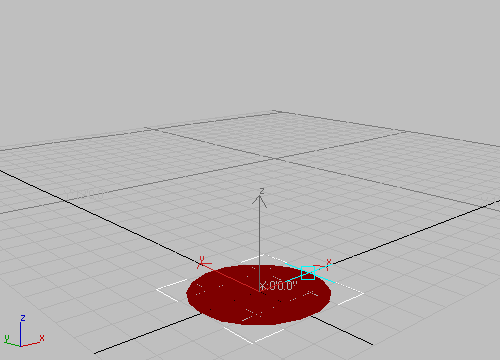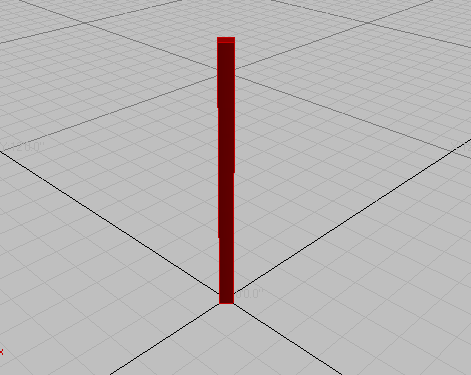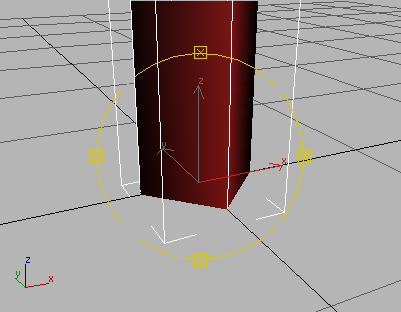Using the Cylinder object, you will create a central pole that will act as the hub for the revolving door. First you will create a new layer for the revolving door.
 (Open File), navigate to
the the startup folder,
and open revolving_door_hub.max.
If you do start with this file, be sure to set up the snaps as described
in the previous lesson.
(Open File), navigate to
the the startup folder,
and open revolving_door_hub.max.
If you do start with this file, be sure to set up the snaps as described
in the previous lesson.
You can use the layer-management system for display and rendering purposes. Here you will create a new layer for the revolving door.
 (Create New Layer).
(Create New Layer).
This creates a new layer and opens the Create New Layer dialog.

The Revolving door layer is now current and visible in the Layers toolbar. Whatever you create now will be on this layer.
Before creating the hub, you will adjust your viewport so you have a better view of the objects you will make.
 (Orbit). In the Perspective
viewport, drag within the navigation orb to change the view of the
home grid so you have a view that is closer to ground level. When
you are done, right-click the viewport to turn off Orbit.
(Orbit). In the Perspective
viewport, drag within the navigation orb to change the view of the
home grid so you have a view that is closer to ground level. When
you are done, right-click the viewport to turn off Orbit. 
Orbit navigation orb
 (3D Snap Toggle) to turn it
on.
(3D Snap Toggle) to turn it
on.
 Create panel, click
Create panel, click  (Geometry). Make sure Standard
Primitives is chosen in the drop-down list, then on the Object Type
rollout, click Cylinder.
(Geometry). Make sure Standard
Primitives is chosen in the drop-down list, then on the Object Type
rollout, click Cylinder.
The Cylinder button highlights to indicate it is active and ready for use.

The cursor displays a blue snap icon and jumps to the grid points.

As you move the mouse away from the center, a flat shaded circle grows from your cursor. You are defining the radius of the cylinder as you move the mouse.
Notice that as you move away from the center of the grid the mouse will snap to grid points.

The snap has been turned off, while you are still in the middle of creating the cylinder. Now as you move your mouse, you are free from the snap control.

Make the cylinder any size you like. You're going to change the size in the next step.
Immediately after creating an object, you can modify its parameters such as size and shape by changing its values on the Parameters rollout on the Create panel.
 Modify panel and adjust
the parameters there, or you can simply
Modify panel and adjust
the parameters there, or you can simply  undo the new object (Ctrl+Z) and start over. If that
happens during this tutorial, we recommend the latter.
undo the new object (Ctrl+Z) and start over. If that
happens during this tutorial, we recommend the latter.
 (Zoom Extents).
(Zoom Extents).
The viewport zooms so you can see the entire cylinder.

Zoom extents to see it all
The Edged Faces option lets you see the edges that 3ds Max Design uses to create the surfaces of your model.

Edged faces show the underlying geometry
The Cylinder changes into a tall box with four sides; this will make it easier to create the door. Later you'll change the pole back to a cylinder.

Reduce the segments
Next you'll rotate the cylinder so the four sides line up with the grid.
 (Zoom) in the viewport navigation
controls. Position the cursor over the bottom of the cylinder and
then press I (the letter
“I”) on the keyboard to center the viewport on the cursor position.
(Zoom) in the viewport navigation
controls. Position the cursor over the bottom of the cylinder and
then press I (the letter
“I”) on the keyboard to center the viewport on the cursor position.

Zoom in and rotate the view.
 (Select And Rotate).
(Select And Rotate).
The transform gizmo appears in the viewport.

The cylinder rotates around the Z axis so the sides line up with the grid.

Cylinder rotated
This will be the pole that revolves to turn the revolving door. You'll snap to its sides when you create an initial Pivot door object. After the other doors are cloned, you can increase the number of sides so it will look like a cylinder again.
Next you will create a tube object to make the door enclosure.